Geochronology and Geochemistry of Archean TTG and Tremolite Schist Xenoliths in Yemadong Complex: Evidence for ≥3.0 Ga Archean Continental Crust in Kongling High-Grade Metamorphic Terrane, Yangtze Craton, China
Abstract
1. Introduction
2. Geological Background and Sample Descriptions
2.1. Geological Background
2.2. Sampling
2.2.1. TTG
2.2.2. Granite Dikes
2.2.3. Biotite–Tremolite Schist
3. Analytical Methods
3.1. Zircon Morphology
3.2. Zircon U–Pb Dating
3.3. Major and Trace Element Analyses
3.4. Zircon Lu–Hf Isotope Analysis
4. Results
4.1. Zircon U–Pb Ages
4.1.1. Biotite-Tremolite Schist
4.1.2. TTG Gneiss
4.1.3. Granite Dikes
4.2. Whole-Rock Major and Trace Element Compositions
4.2.1. Biotite-Tremolite Schist
4.2.2. TTG Gneiss and Dikes
4.2.3. Granite Dikes
4.2.4. Zircon Hf-Isotope
5. Discussion
5.1. Petrogenesis
5.1.1. Biotite-Tremolite Schist
5.1.2. TTG Magmatism
5.2. Tectonic Implications
6. Conclusions
Supplementary Materials
Author Contributions
Funding
Acknowledgments
Conflicts of Interest
References
- Hacker, B.R.; Ratschbacher, L.; Webb, L.; Ireland, T.; Walker, D.; Shuwen, D. U/Pb zircon ages constrain the architecture of the ultrahigh–pressure Qinling–Dabie Orogen, China. Earth Planet. Sci. Lett. 1998, 161, 215–230. [Google Scholar] [CrossRef]
- Li, S.; Xiao, Y.; Liou, D.; Chen, Y.; Ge, N.; Zhang, Z.; Sun, S.S.; Cong, B.; Zhang, R.; Hart, S.R.; et al. Collision of the North. China and Yangtse Blocks and formation of coesite-bearing eclogites: Timing and processes. Chem. Geol. 1993, 109, 89–111. [Google Scholar] [CrossRef]
- Zhang, S.B.; Zheng, Y.F. Formation and evolution of Precambrian continental lithosphere in South China. Gondwana Res. 2013, 23, 1241–1260. [Google Scholar] [CrossRef]
- Wu, Y.B.; Zheng, Y.F.; Gao, S.; Jiao, W.F.; Liu, Y.S. Zircon U–Pb age and trace element evidence for Paleoproterozoic granulite-facies metamorphism and Archean crustal rocks in the Dabie Orogen. Lithos 2008, 101, 308–322. [Google Scholar] [CrossRef]
- Wu, F.Y.; Zhang, Y.B.; Yang, J.H.; Xie, L.W.; Yang, Y.H. Zircon U–Pb and Hf isotopic constraints on the Early Archean crustal evolution in Anshan of the North China Craton. Precambrian Res. 2008, 167, 339–362. [Google Scholar] [CrossRef]
- Song, B.; Nutman, A.P.; Liu, D.; Wu, J. 3800 to 2500 Ma crustal evolution in the Anshan area of Liaoning Province, northeastern China. Precambrian Res. 1996, 78, 79–94. [Google Scholar] [CrossRef]
- Gao, S.; Yang, J.; Hu, Z.C.; Yuan, H.L.; Gong, H.J.; Li, M.; Xiao, G.Q.; Wei, J.Q. Age and growth of the Archean Kongling terrain, South. China, with emphasis on 3.3 Ga granitoid gneisses. Geochim. Cosmochim. Acta Suppl. 2011, 72, 153–182. [Google Scholar] [CrossRef]
- Jiao, W.F.; Wu, Y.B.; Yang, S.H.; Peng, M.; Wang, J. The oldest basement rock in the Yangtze Craton revealed by zircon U–Pb age and Hf isotope composition. Sci. China Ser. D–Earth Sci. 2009, 52, 1393–1399. [Google Scholar] [CrossRef]
- Qiu, Y.; Gao, S.; Mcnaughton, N.J.; Groves, D.I.; Ling, W. First evidence of >3.2Ga continental crust in the Yangtze craton of south China and its implications for Archean crustal evolution and Phanerozoic tectonics. Geology 2000, 28, 11–14. [Google Scholar] [CrossRef]
- Zhang, S.B.; Zheng, Y.F.; Wu, Y.B.; Zhao, Z.F.; Gao, S.; Wu, F.Y. Zircon U–Pb age and Hf isotope evidence for 3.8 Ga crustal remnant and episodic reworking of Archean crust in South China. Earth Planet. Sci. Lett. 2006, 252, 56–71. [Google Scholar] [CrossRef]
- Qiu, X.F.; Ling, W.L.; Liu, X.M.; Lu, S.S.; Jiang, T.; Wei, Y.X.; Peng, L.H.; Tan, J.J. Evolution of the Archean continental crust in the nucleus of the Yangtze block: Evidence from geochemistry of 3.0 Ga TTG gneisses in the Kongling high-grade metamorphic terrane, South China. J. Asian Earth Sci. 2018, 154, 149–161. [Google Scholar] [CrossRef]
- Ling, W.; Gao, S.; Zheng, H.; Zhou, L.; Zhao, Z. Sm–Nd isotope geochronology of the Qiling complex in the Huangling area of the Yangtze Craton. Chin. Sci. Bull. 1998, 43, 86. [Google Scholar]
- Guo, J.L.; Gao, S.; Wu, Y.B.; Li, M.; Chen, K.; Hu, Z.C.; Liang, Z.W.; Liu, Y.S.; Zhou, L.; Zong, K.Q.; et al. 3.45 Ga granitic gneisses from the Yangtze Craton, South China: Implications for Early Archean crustal growth. Precambrian Res. 2014, 242, 82–95. [Google Scholar] [CrossRef]
- Liu, X.; Gao, S.; Diwu, C.; Ling, W. Precambrian crustal growth of Yangtze Craton as revealed by detrital zircon studies. Am. Sci. 2008, 308, 421–468. [Google Scholar]
- Chen, K.; Gao, S.; Wu, Y.B.; Guo, J.L.; Hu, Z.C.; Liu, Y.S.; Zong, K.Q.; Liang, Z.W.; Geng, X.L. 2.6–2.7 Ga crustal growth in Yangtze craton, South China. Precambrian Res. 2013, 224, 472–490. [Google Scholar] [CrossRef]
- Guo, J.L.; Wu, Y.B.; Gao, S.; Jin, Z.M.; Zong, K.Q.; Hu, Z.C.; Chen, K.; Chen, H.H.; Liu, Y.S. Episodic Paleoarchean–Paleoproterozoic (3.3–2.0 Ga) granitoid magmatism in Yangtze Craton, South China: Implications for late Archean tectonics. Precambrian Res. 2015, 270, 246–266. [Google Scholar] [CrossRef]
- Zhang, S.B.; Zheng, Y.F.; Wu, Y.B.; Zhao, Z.F.; Gao, S.; Wu, F.Y. Zircon U–Pb age and Hf–O isotope evidence for Paleoproterozoic metamorphic event in South China. Precambrian Res. 2006, 151, 265–288. [Google Scholar] [CrossRef]
- Li, Z.; Li, X.; Zhou, H.; Kinny, P.D. Grenvillian continental collision in south China: New SHRIMP U–Pb zircon results and implications for the configuration of Rodinia. Geology 2002, 30, 163–166. [Google Scholar] [CrossRef]
- Gao, S.; Ling, W.L.; Qiu, Y.M.; Lian, Z.; Hartmann, G.; Simon, K. Contrasting geochemical and Sm–Nd isotopic compositions of Archean metasediments from the Kongling high-grade terrain of the Yangtze craton: Evidence for cratonic evolution and redistribution of REE during crustal anatexis. Geochim. Cosmochim. Acta 1999, 63, 2071–2088. [Google Scholar] [CrossRef]
- Ling, W.; Gao, S.; Cheng, J.; Jiang, L.; Yuan, H.; Hu, Z. Neoproterozoic magmatic events within the Yangtze continental interior and along its northern margin and their tectonic implication: Constraint from the ELA–ICPMS U–Pb geochronogy of zicrons from the Huangling and Hannan complexes. Acta Petrol. Sin. 2006, 22, 387–396. [Google Scholar]
- Wei, Y.X.; Peng, S.B.; Jiang, X.F.; Peng, Z.Q.; Peng, L.H.; Li, Z.H.; Zhou, P.; Zeng, X. SHRIMP zircon U–Pb ages and geochemical characteristics of the neoproterozoic granitoids in the Huangling anticline and its tectonic setting. J. Earth Sci. 2012, 23, 659–676. [Google Scholar] [CrossRef]
- Zhang, S.B.; Zheng, Y.F.; Zhao, Z.F.; Wu, Y.B.; Yuan, H.; Wu, F.Y. Neoproterozoic anatexis of Archean lithosphere: Geochemical evidence from felsic to mafic intrusions at Xiaofeng in the Yangtze Gorge, South China. Precambrian Res. 2008, 163, 210–238. [Google Scholar] [CrossRef]
- Zhang, S.B.; Zheng, Y.F.; Wu, Y.B.; Zhao, Z.F.; Gao, S.; Wu, F.Y. Zircon isotope evidence for ≥3.5 Ga continental crust in the Yangtze craton of China. Precambrian Res. 2006, 146, 16–34. [Google Scholar] [CrossRef]
- Song, B.; Zhang, Y.H.; Wan, Y.S.; Jian, P. Mount making and procedure of shrimp dating. Geol. Rev. 2002, 48, 26–30. [Google Scholar]
- Ballard, J.R.; Palin, J.M.; Williams, I.S.; Campbell, I.H.; Faunes, A. Two ages of porphyry intrusion resolved for the super-giant Chuquicamata copper deposit of northern Chile by ELA–ICP–MS and SHRIMP. Geology 2001, 29, 383–386. [Google Scholar] [CrossRef]
- Yuan, H.; Gao, S.; Liu, X.; Li, H.; Günther, D.; Wu, F. Accurate U–Pb age and trace element determinations of zircon by laser ablation–inductively coupled plasma-mass spectrometry. Geostand. Geoanalytical Res. 2004, 28, 353–370. [Google Scholar] [CrossRef]
- Andersen, T. Correction of common lead in U–Pb analyses that do not report 204Pb. Chem. Geol. 2002, 192, 59–79. [Google Scholar] [CrossRef]
- Ludwig, K.R. Isoplot 3.00: A geochronological toolkit for Microsoft Excel. Berkeley Geochronol. Cent. Spec. Publ. 2003, 4, 1–70. [Google Scholar]
- Hu, Z.; Liu, Y.; Gao, S.; Liu, W.; Zhang, W.; Tong, X.; Lin, L.; Zong, K.; Li, M.; Chen, H. Improved in situ Hf isotope ratio analysis of zircon using newly designed X skimmer cone and jet sample cone in combination with the addition of nitrogen by laser ablation multiple collector ICP–MS. J. Anal. At. Spectrom. 2012, 27, 1391–1399. [Google Scholar] [CrossRef]
- Sun, S.S.; McDonough, W.F. Chemical and isotopic systematic of oceanic basalts: Implication and processes/Magmatism in the Ocean Basins. Geollogical Soc. Lond. Spec. Publ. 1989, 42, 313–345. [Google Scholar] [CrossRef]
- Hu, Z.; Liu, Y.; Gao, S.; Xiao, S.; Zhao, L.; Günther, D.; Li, M.; Zhang, W.; Zong, K. A “wire” signal smoothing device for laser ablation inductively coupled plasma mass spectrometry analysis. Spectrochim. Acta Part B At. Spectrosc. 2012, 78, 50–57. [Google Scholar] [CrossRef]
- Winchester, J.A.; Floyd, P.A. Geochemical discrimination of different magma series and their differentiation products using immobile elements. Chem. Geol. 1977, 20, 325–343. [Google Scholar] [CrossRef]
- Pearce, J.A. A user’s guide to basalt discrimination diagrams. In Trace Element Geochemistry of Volcanic Rocks: Applications for Massive Sulphide Exploration; Geological Association of Canada: Toronto, ON, Canada, 1996; Volume 12, pp. 79–113. [Google Scholar]
- Miyashiro, A. Volcanic rock series in island arcs and active continental margins. Am. J. Sci. 1974, 274, 321–355. [Google Scholar] [CrossRef]
- O’connor, J. A classification for quartz–rich igneous rocks based on feldspar ratios. Geol. Surv. Prof. Pap. 1965, 525, 79–84. [Google Scholar]
- Maniar, P.D.; Piccoli, P.M. Tectonic discrimination of granitoids. Geol. Soc. Am. Bull. 1989, 101, 635–643. [Google Scholar] [CrossRef]
- Frost, B.R.; Barnes, C.G.; Collins, W.J.; Arculus, R.J.; Ellis, D.J.; Frost, C.D. A geochemical classification for granitic rocks. J. Petrol. 2001, 42, 2033–2048. [Google Scholar] [CrossRef]
- Peng, M.; Wu, Y.; Gao, S.; Zhang, H.; Wang, J.; Liu, X.; Gong, H.; Zhou, L.; Hu, Z.; Liu, Y.; et al. Geochemistry, zircon U–Pb age and Hf isotope compositions of Paleoproterozoic aluminous A-type granites from the Kongling terrain, Yangtze Block: Constraints on petrogenesis and geologic implications. Gondwana Res. 2012, 22, 140–151. [Google Scholar] [CrossRef]
- Xiong, Q.; Zheng, J.P.; Yu, C.M.; Su, Y.P.; Tang, H.Y.; Zhang, Z.H. Zircon U–Pb age and Hf isotope of Quanyishang A-type granite in Yichang: Signification for the Yangtze continental cratonization in Paleoproterozoic. Chin. Sci. Bull. 2009, 54, 436–446. [Google Scholar] [CrossRef]
- Li, L.; Lin, S.; Davis, D.W.; Xiao, W.; Xing, G.; Yin, C. Geochronology and geochemistry of igneous rocks from the Kongling terrane: Implications for Mesoarchean to Paleoproterozoic crustal evolution of the Yangtze Block. Precambrian Res. 2014, 255, 30–47. [Google Scholar] [CrossRef]
- Gao, S.; Zhang, B.R. Discovery of the Archean TTG gneiss in the northern part of the Yangtze platform and its significance. Earth Sci.–J. China Univ. Geosci. 1990, 15, 675–679. [Google Scholar]
- Bouvier, A.; Vervoort, J.D.; Patchett, P.J. The Lu–Hf and Sm–Nd isotopic composition of CHUR: Constraints from unequilibrated chondrites and implications for the bulk composition of terrestrial planets. Earth Planet. Sci. Lett. 2008, 273, 48–57. [Google Scholar] [CrossRef]
- Söderlund, U.; Patchett, P.J.; Vervoort, J.D.; Isachsen, C.E. The 176Lu decay constant determined by Lu–Hf and U–Pb isotope systematics of Precambrian mafic intrusions. Earth Planet. Sci. Lett. 2004, 219, 311–324. [Google Scholar] [CrossRef]
- Griffin, W.L.; Wang, X.; Jackson, S.E.; Pearson, N.J.; O’Reilly, S.Y.; Xu, X.; Zhou, X. Zircon chemistry and magma mixing, SE China: In-situ analysis of Hf isotopes, Tonglu and Pingtan igneous complexes. Lithos 2002, 61, 237–269. [Google Scholar] [CrossRef]
- Vervoort, J.D.; Patchett, P.J. Behavior of hafnium and neodymium isotopes in the crust: Constraints from Precambrian crustally derived granites. Geochim. Cosmochim. Acta 1996, 60, 3717–3733. [Google Scholar] [CrossRef]
- Wei, J.Q.; Jing, M.M. Chronology and geochemistry of amphibolites from the Kongling complex. Chin. J. Geol. 2013, 48, 970–983. [Google Scholar]
- Polat, A.; Hofmann, A. Alteration and geochemical patterns in the 3.7–3.8 Ga Isua greenstone belt, West Greenland. Precambrian Res. 2003, 126, 197–218. [Google Scholar] [CrossRef]
- Polat, A.; Hofmann, A.; Rosing, M.T. Boninite-like volcanic rocks in the 3.7–3.8 Ga Isua greenstone belt, West Greenland: Geochemical evidence for intra-oceanic subduction zone processes in the early Earth. Chem. Geol. 2002, 184, 231–254. [Google Scholar] [CrossRef]
- Zheng, J.; Griffin, W.; O’Reilly, S.Y.; Zhang, M.; Pearson, N.; Pan, Y. Widespread Archean basement beneath the Yangtze craton. Geology 2006, 34, 417–420. [Google Scholar] [CrossRef]
- Defant, M.J.; Drummond, M.S. Derivation of some modern arc magmas by melting of young subducted lithosphere. Nature 1990, 347, 662. [Google Scholar] [CrossRef]
- Barker, F.; Arth, J.G. Generation of trondhjemitic-tonalitic liquids and Archean bimodal trondhjemite-basalt suites. Geology 1976, 4, 596–600. [Google Scholar] [CrossRef]
- Castillo, P.R. An overview of adakite petrogenesis. Chin. Sci. Bull. 2006, 51, 257–268. [Google Scholar] [CrossRef]
- Gao, Y.; Yang, Z.; Santosh, M.; Hou, Z.; Wei, R.; Tian, S. Adakitic rocks from slab melt-modified mantle sources in the continental collision zone of southern Tibet. Lithos 2010, 119, 651–663. [Google Scholar] [CrossRef]
- Chung, S.L.; Liu, D.; Ji, J.; Chu, M.F.; Lee, H.Y.; Wen, D.J.; Lo, C.H.; Lee, T.Y.; Qian, Q.; Zhang, Q. Adakites from continental collision zones: Melting of thickened lower crust beneath southern Tibet. Geology 2003, 31, 1021–1024. [Google Scholar] [CrossRef]
- Gao, S.; Rudnick, R.L.; Yuan, H.L.; Liu, X.M.; Liu, Y.S.; Xu, W.L.; Ling, W.L.; Ayers, J.; Wang, X.C.; Wang, Q.H. Recycling lower continental crust in the North China craton. Nature 2004, 432, 892–897. [Google Scholar] [CrossRef] [PubMed]
- Moyen, J.F. High Sr/Y and La/Yb ratios: The meaning of the “adakitic signature”. Lithos 2009, 112, 556–574. [Google Scholar] [CrossRef]
- Moyen, J.F. The composite Archaean grey gneisses: Petrological significance, and evidence for a non-unique tectonic setting for Archaean crustal growth. Lithos 2011, 123, 21–36. [Google Scholar] [CrossRef]
- Martin, H.; Moyen, J.F. Secular changes in tonalite–trondhjemite–granodiorite composition as markers of the progressive cooling of Earth. Geology 2002, 30, 319–322. [Google Scholar] [CrossRef]
- Martin, H.; Smithies, R.; Rapp, R.; Moyen, J.F.; Champion, D. An overview of adakite, tonalite–trondhjemite–granodiorite (TTG), and sanukitoid: Relationships and some implications for crustal evolution. Lithos 2005, 79, 1–24. [Google Scholar] [CrossRef]
- Moyen, J.F.; Martin, H. Forty years of TTG research. Lithos 2012, 148, 312–336. [Google Scholar] [CrossRef]
- Wei, J.; Wang, J. Zircon age and Hf isotope compositions of amphibolite enclaves from the Kongling complex. Geol. J. China Univ. 2012, 18, 589–600. [Google Scholar]
- Laurent, O.; Martin, H.; Moyen, J.F.; Doucelance, R. The diversity and evolution of late-Archean granitoids: Evidence for the onset of “modern-style” plate tectonics between 3.0 and 2.5 Ga. Lithos 2014, 205, 208–235. [Google Scholar] [CrossRef]
- Schaltegger, U.; Zeilinger, G.; Frank, M.; Burg, J.P. Multiple mantle sources during island arc magmatism: U–Pb and Hf isotopic evidence from the Kohistan arc complex, Pakistan. Terra Nova 2002, 14, 461–468. [Google Scholar] [CrossRef]
- Ducea, M.N.; Saleeby, J.B.; Bergantz, G. The Architecture, Chemistry, and Evolution of Continental Magmatic Arcs. Annu. Rev. Earth Planet. Sci. 2015, 43, 299–331. [Google Scholar] [CrossRef]
- Jones, R.E.; Kirstein, L.A.; Kasemann, S.A.; Dhuime, B.; Elliott, T.; Litvak, V.D.; Alonso, R.; Hinton, R.; Facility, E.I.M. Geodynamic controls on the contamination of Cenozoic arc magmas in the southern Central Andes: Insights from the O and Hf isotopic composition of zircon. Geochim. Cosmochim. Acta 2015, 164, 386–402. [Google Scholar] [CrossRef]
- Li, Z.X.; Li, X.H.; Chung, S.L.; Lo, C.H.; Xu, X.; Li, W.X. Magmatic switch-on and switch-off along the South China continental margin since the Permian: Transition from an Andean-type to a Western Pacific-type plate boundary. Tectonophysics 2012, 532, 271–290. [Google Scholar] [CrossRef]
- Han, Q.S.; Peng, S.B.; Polat, A.; Kusky, T.; Deng, H.; Wu, T.Y. A ca.2.1 Ga Andean-type margin built on metasomatized lithosphere in the northern Yangtze craton, China: Evidence from high-Mg basalts and andesites. Precambrian Res. 2017, 309, 309–324. [Google Scholar] [CrossRef]
- Ling, W.L.; Gao, S. The tectonic thermal events and the evolution in the late Paleoproterozoic of the Yangtze craton in the Yangtze. Chin. Sci. Bull. 2000, 45, 2343–2347. [Google Scholar]
- Peng, S.; Han, Q.; Polat, A.; Kusky, T.M. The discovery of Paleoproterozoic ophiolitic melange in the northern part of the Huangling Dome of the Yangtze Craton. J. Earth Sci. 2016, 41, 2117–2118. [Google Scholar]
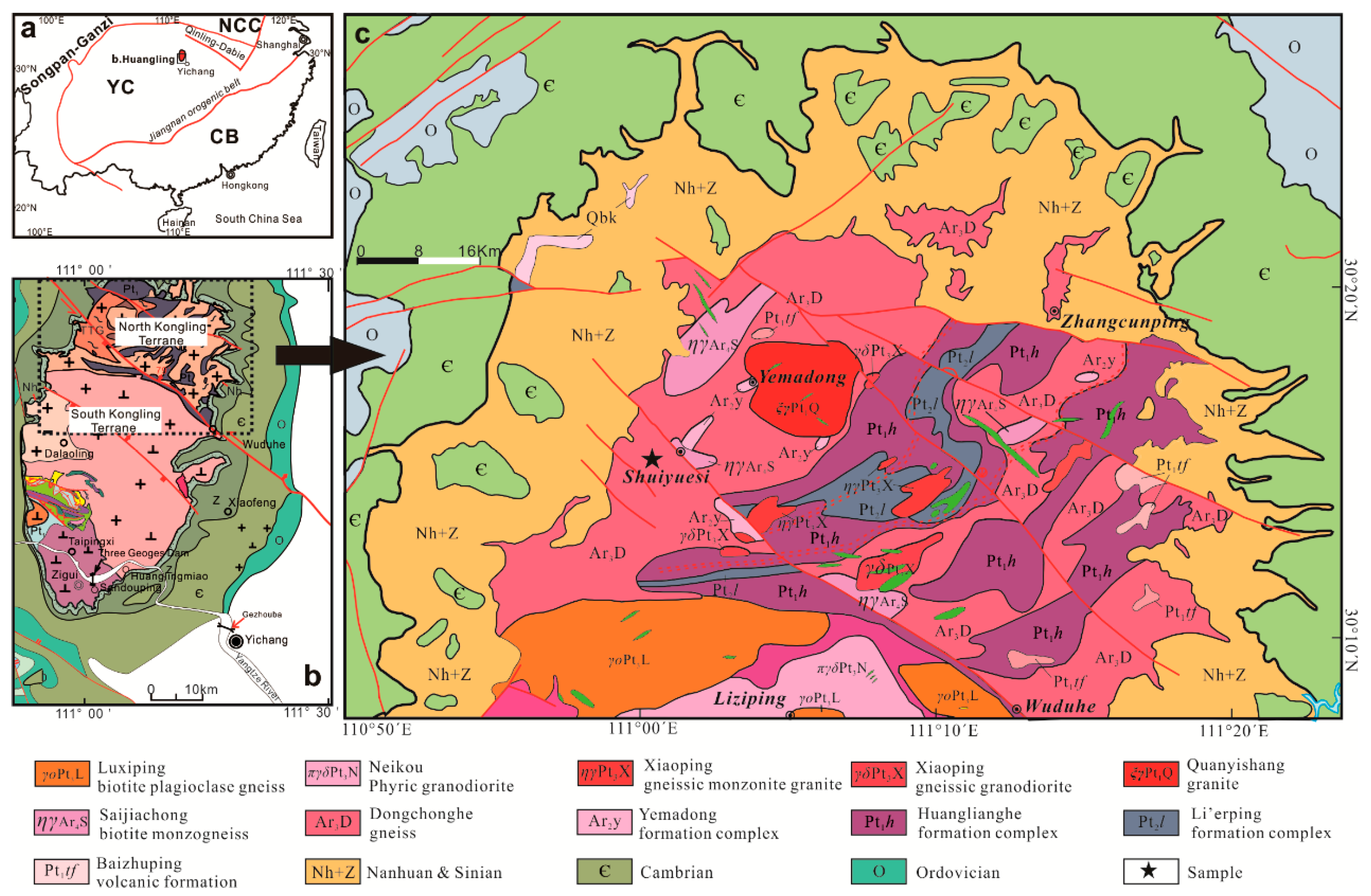
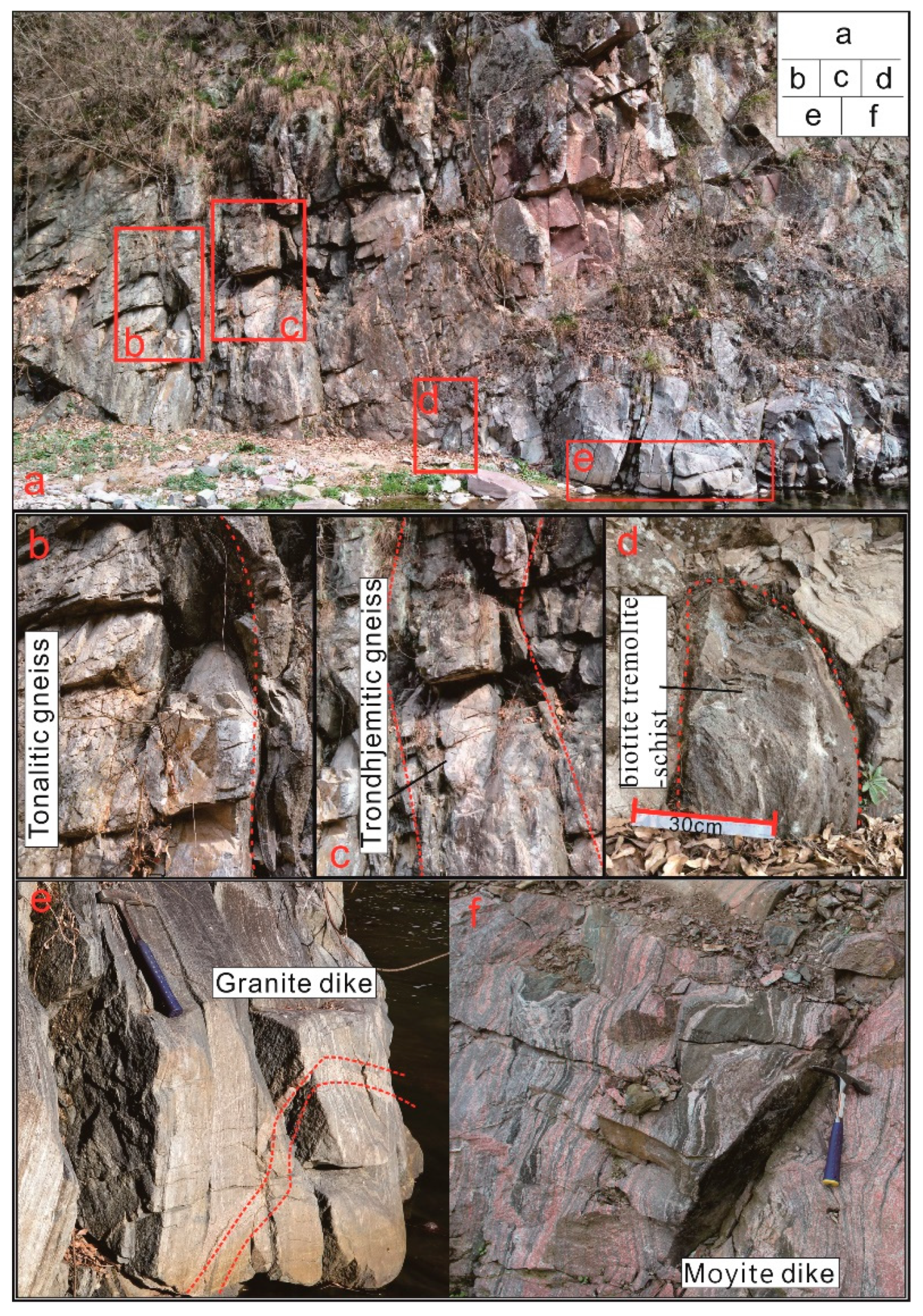
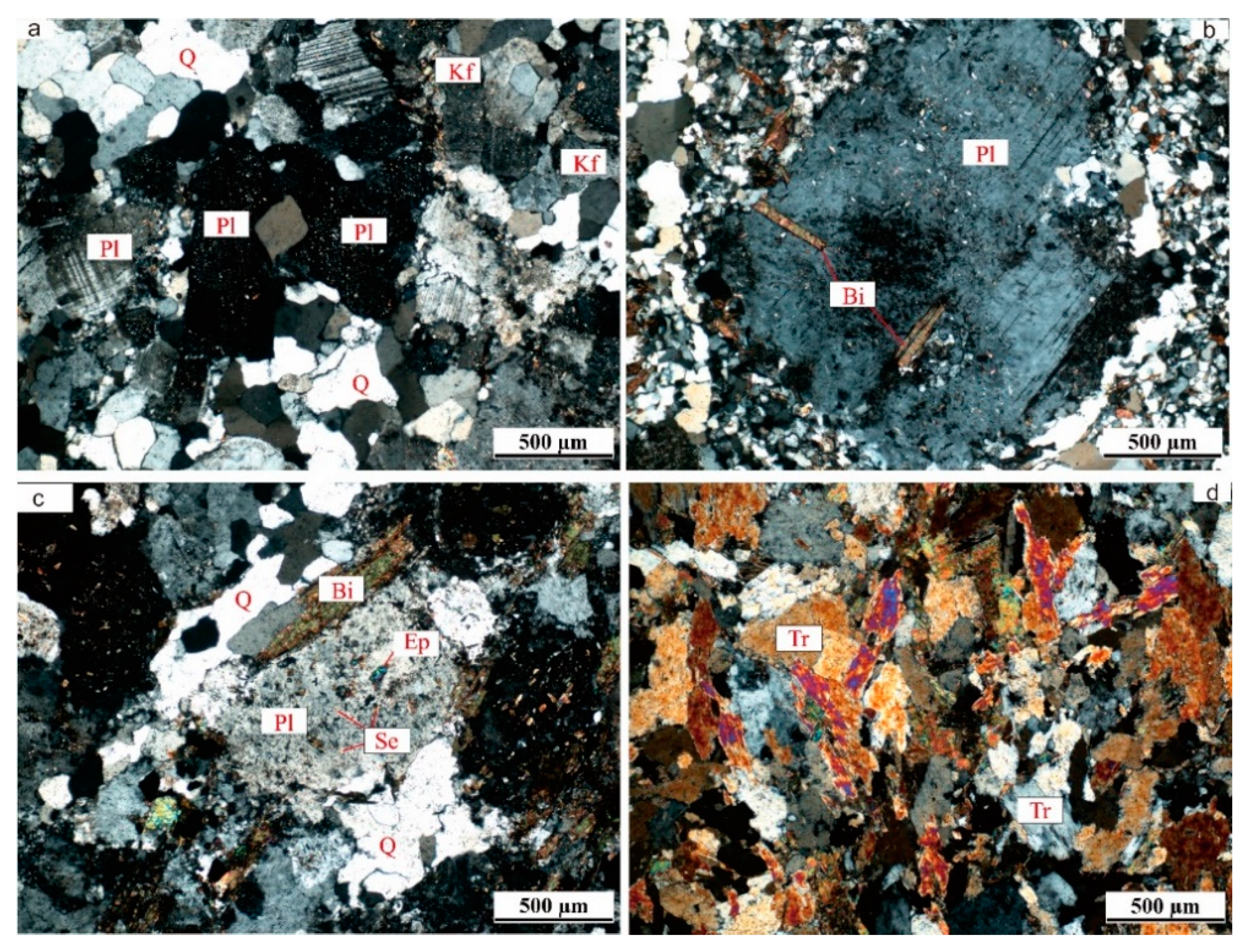
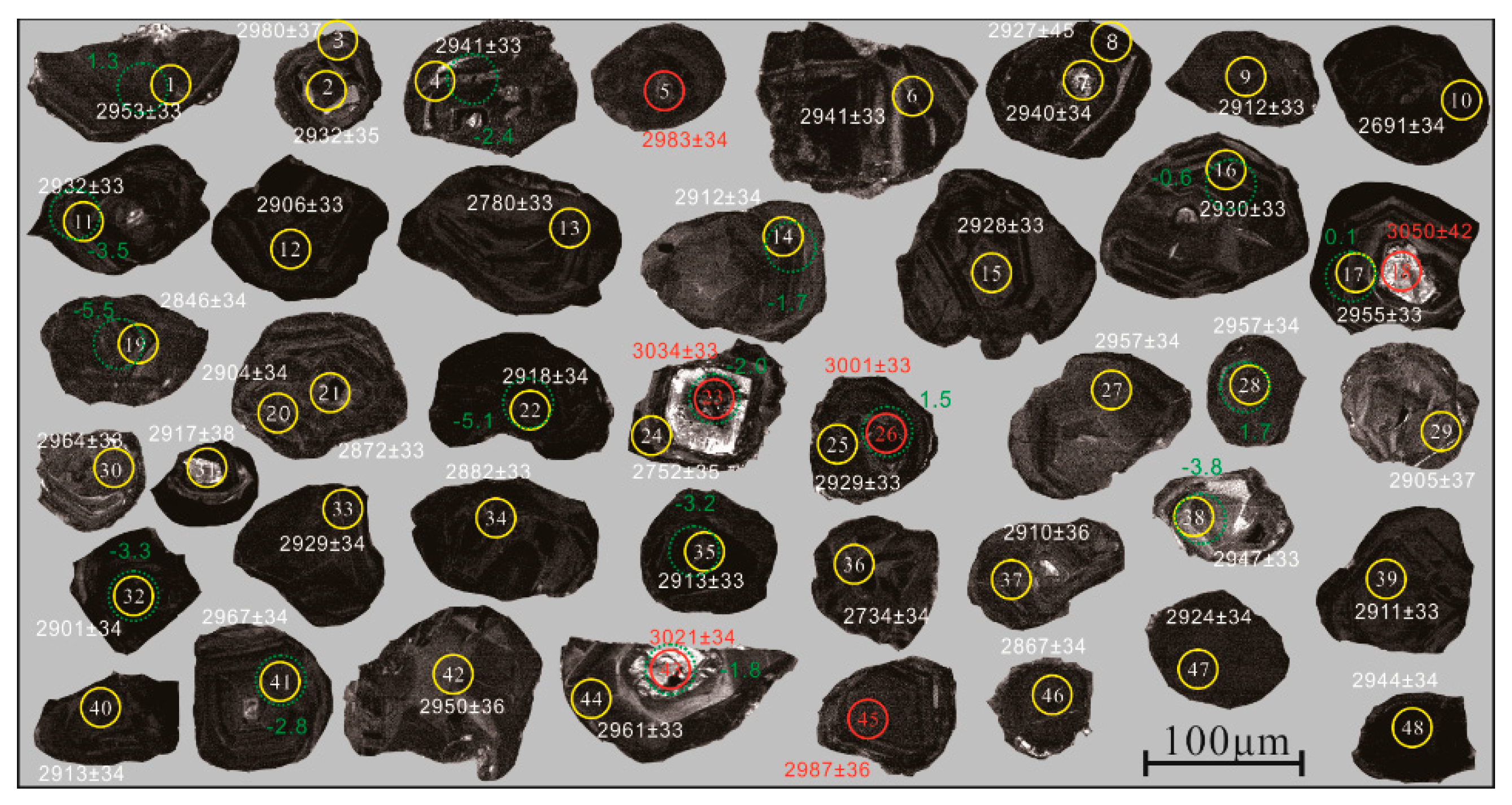
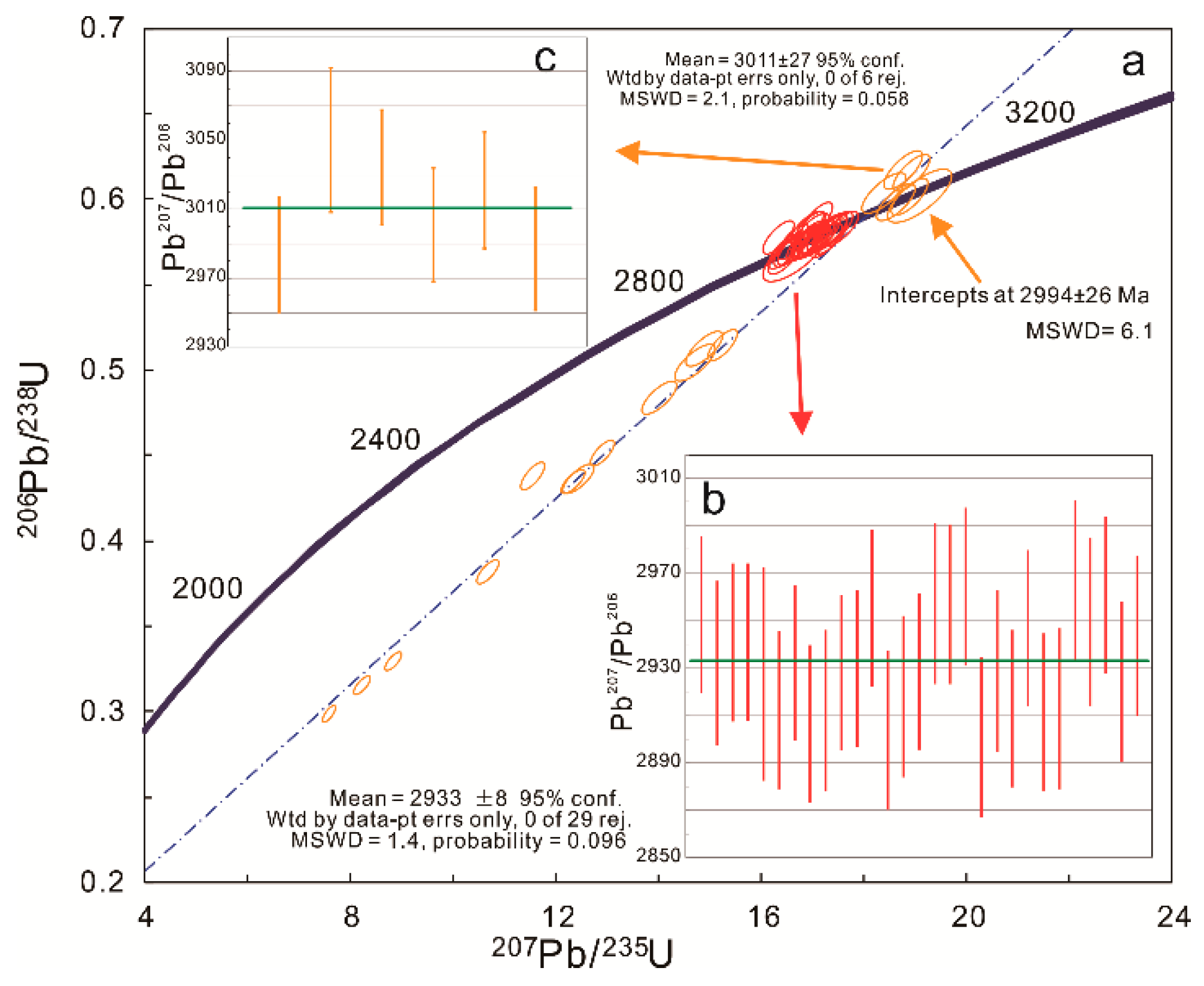
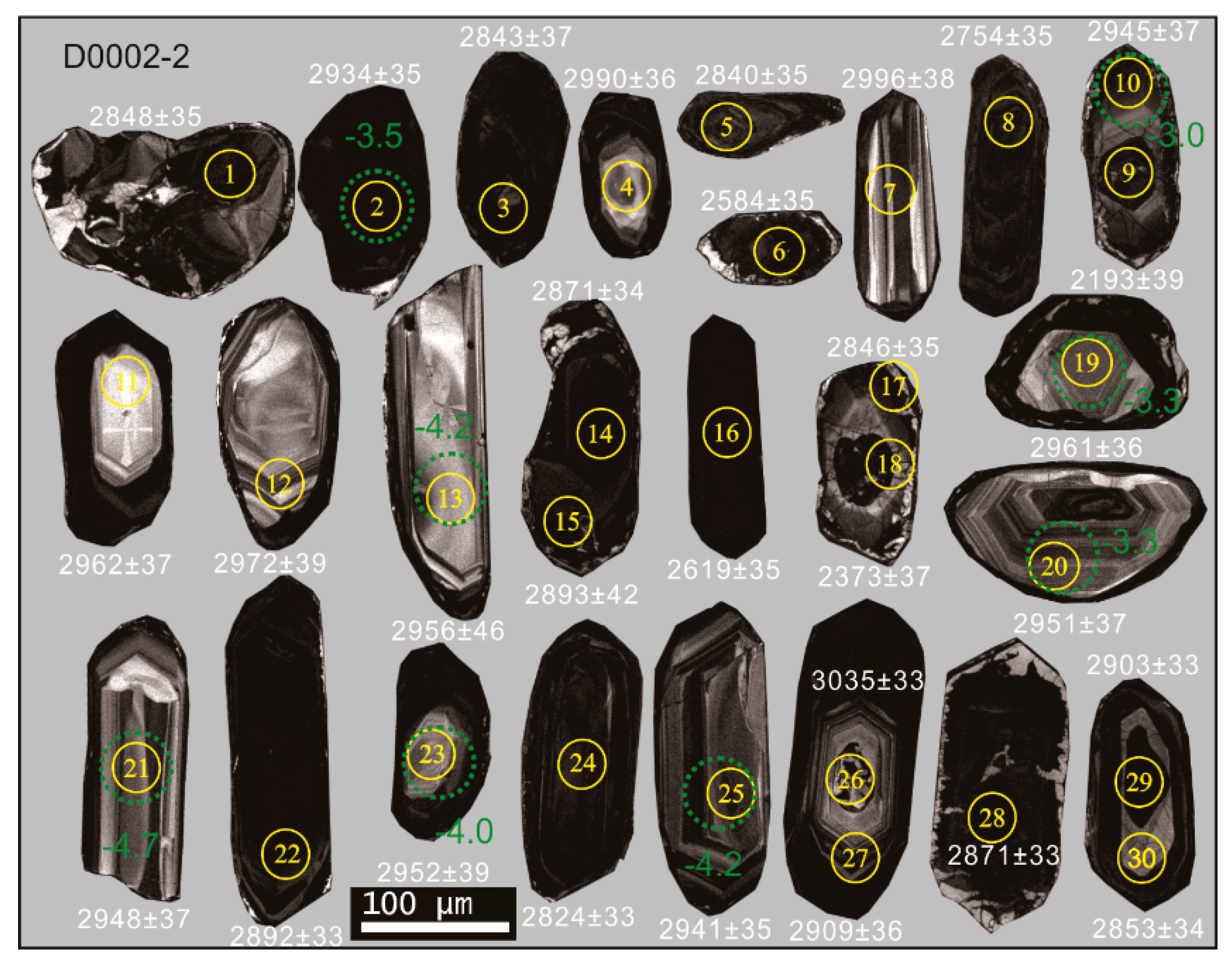
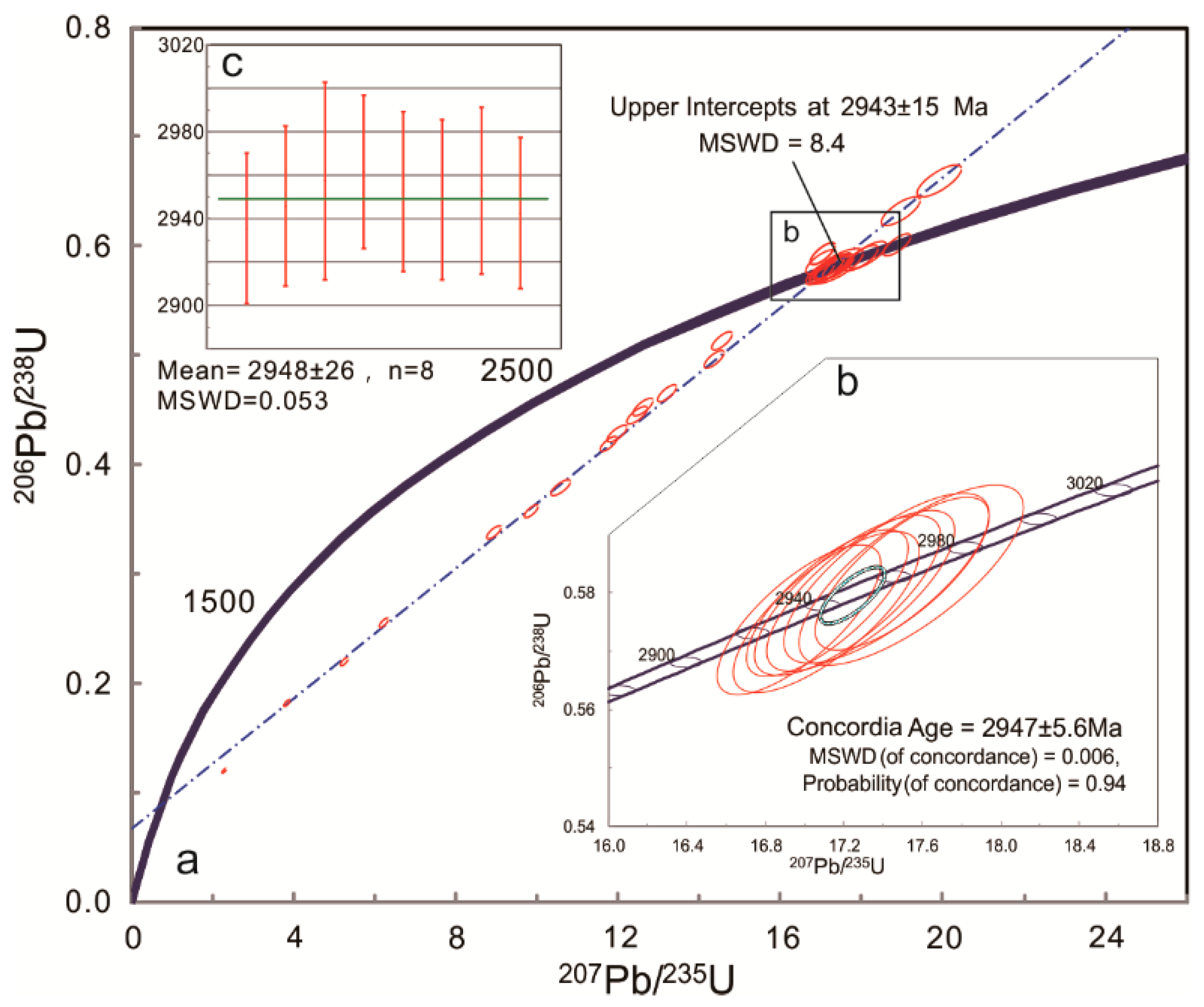
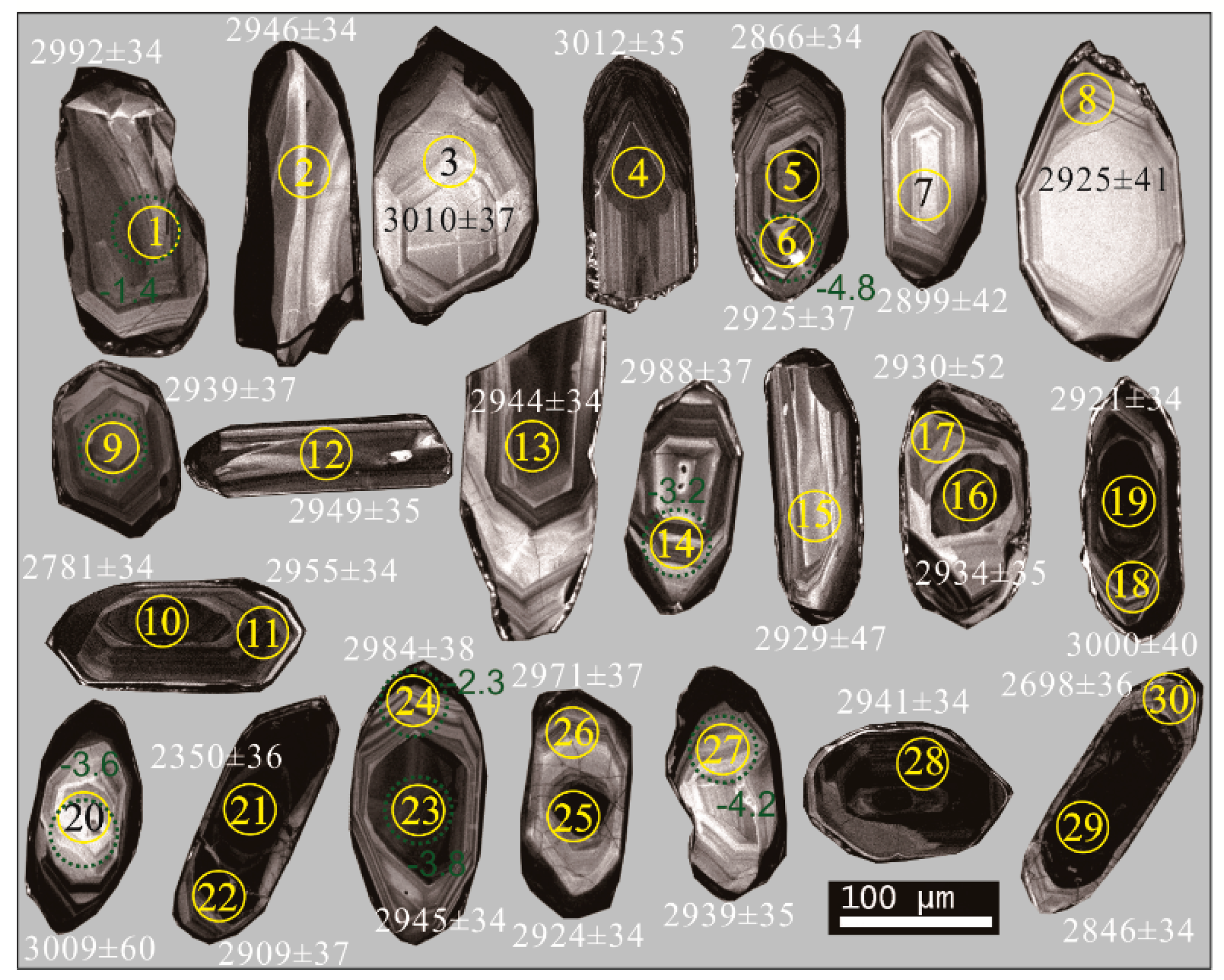
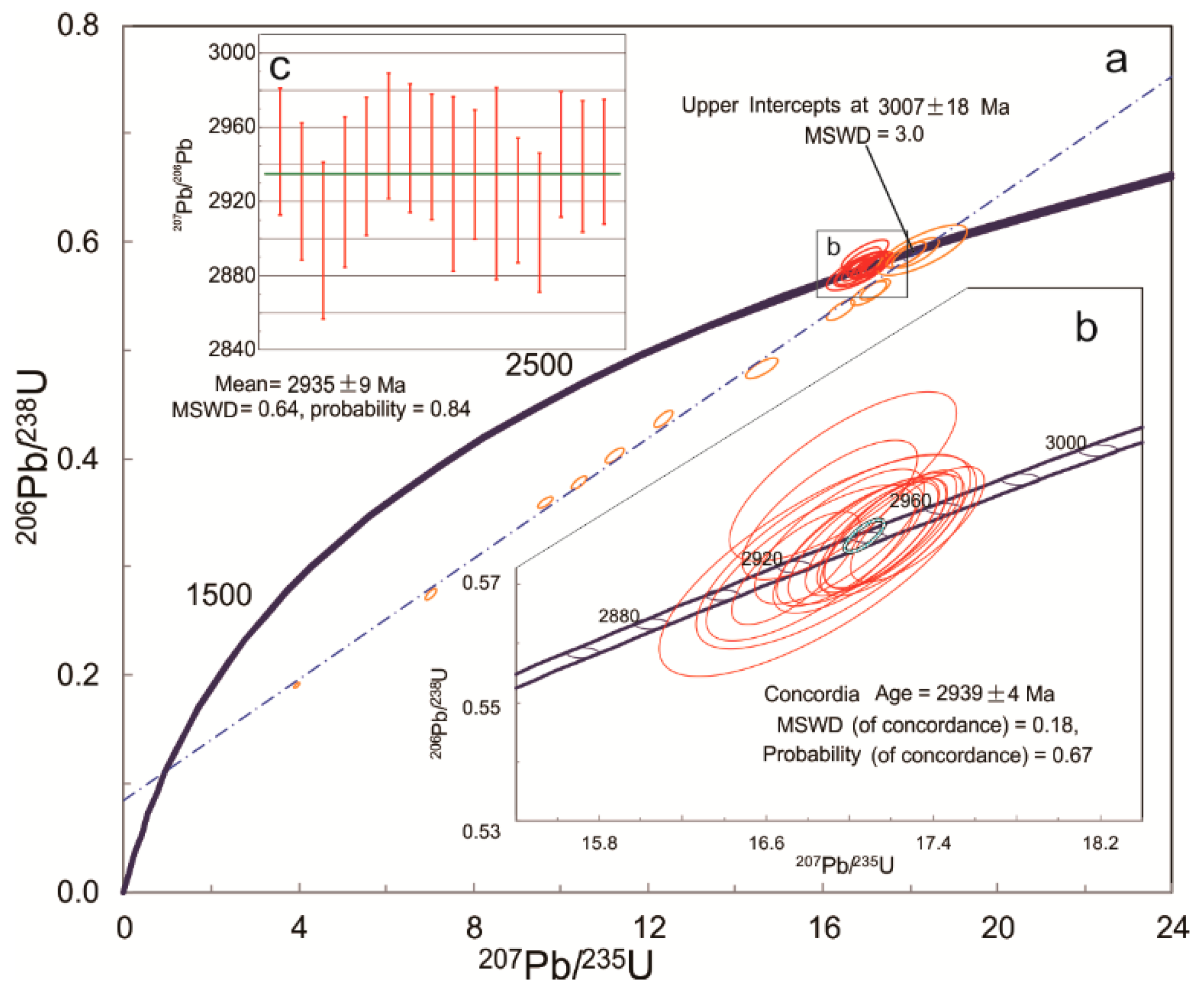
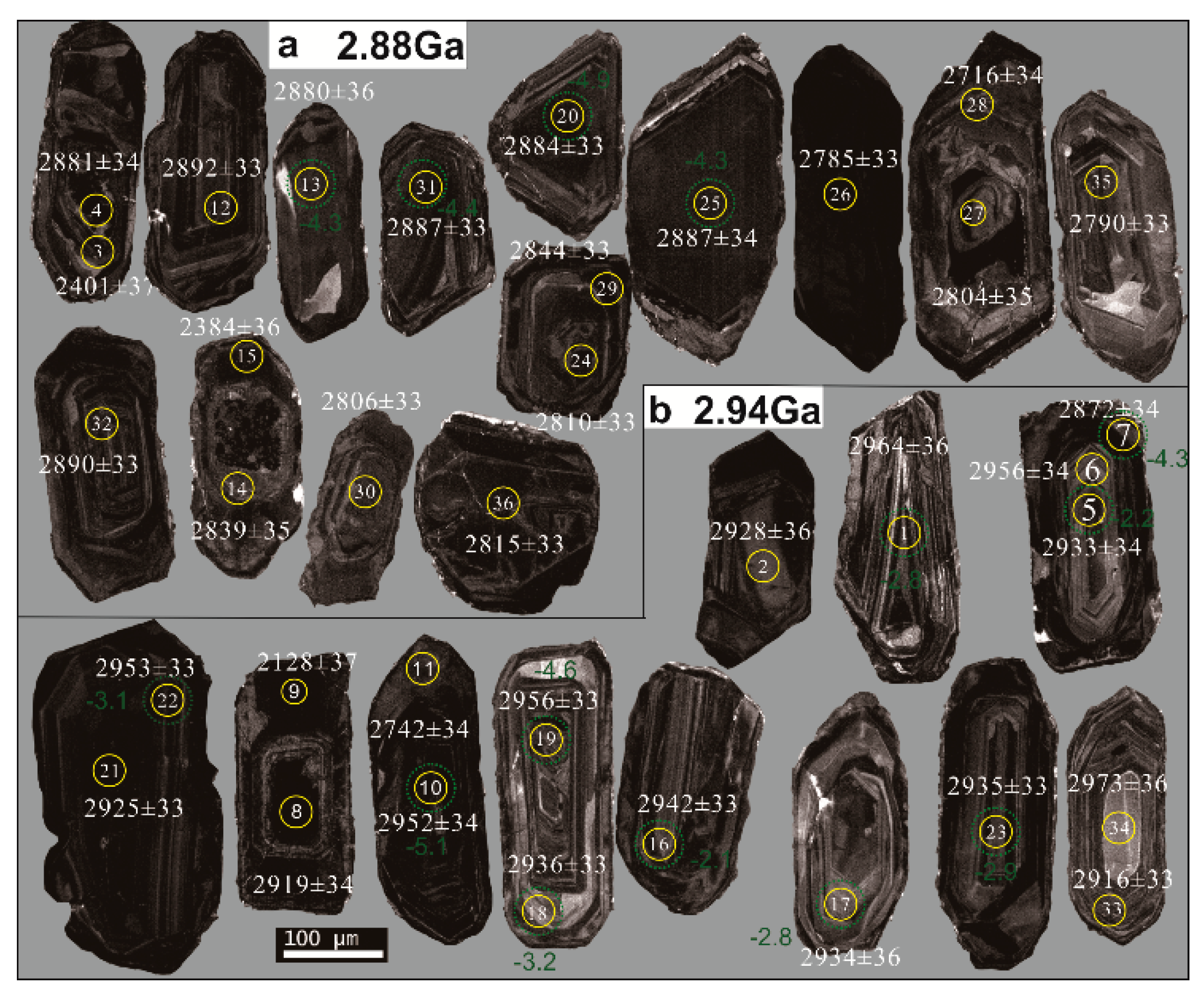
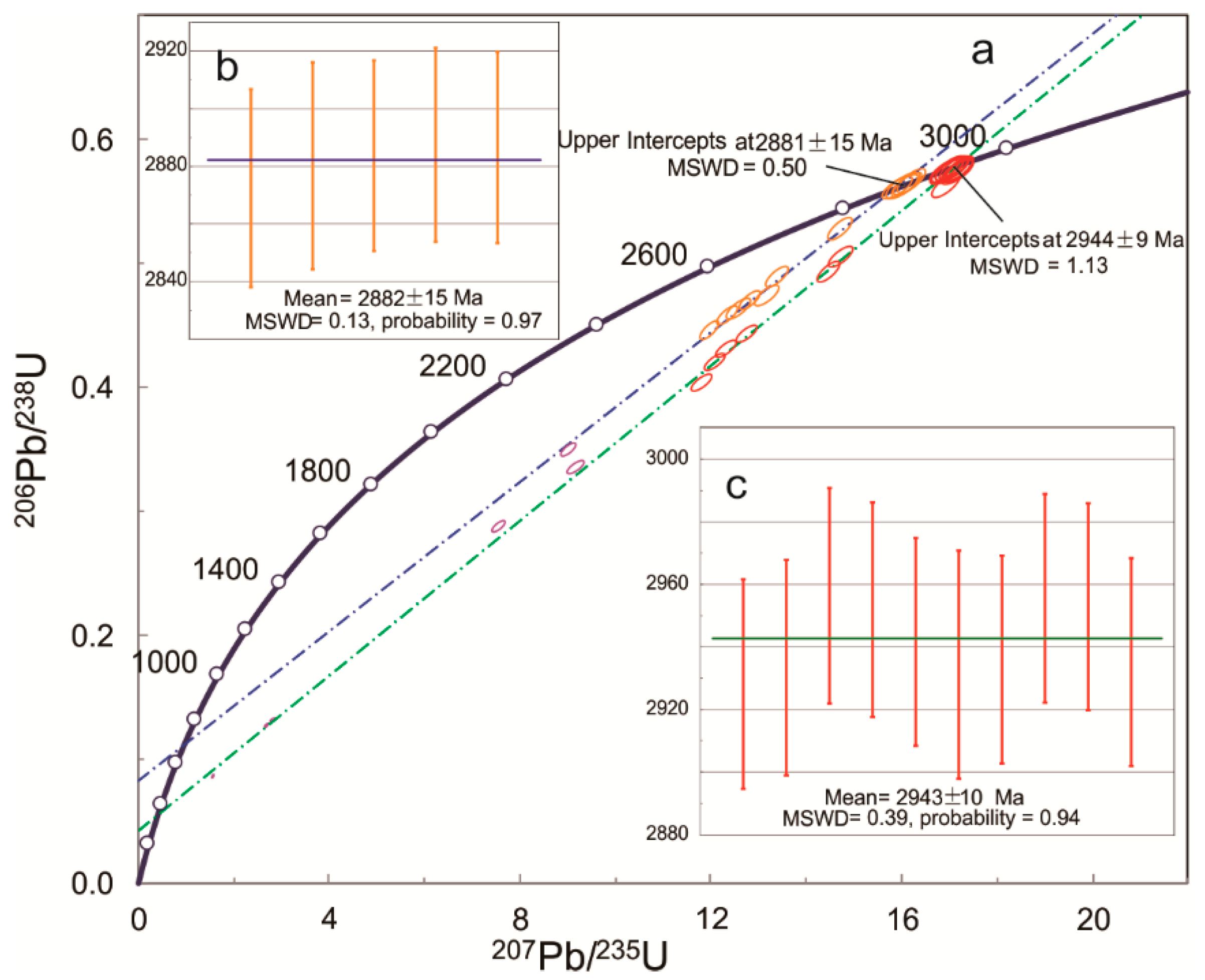
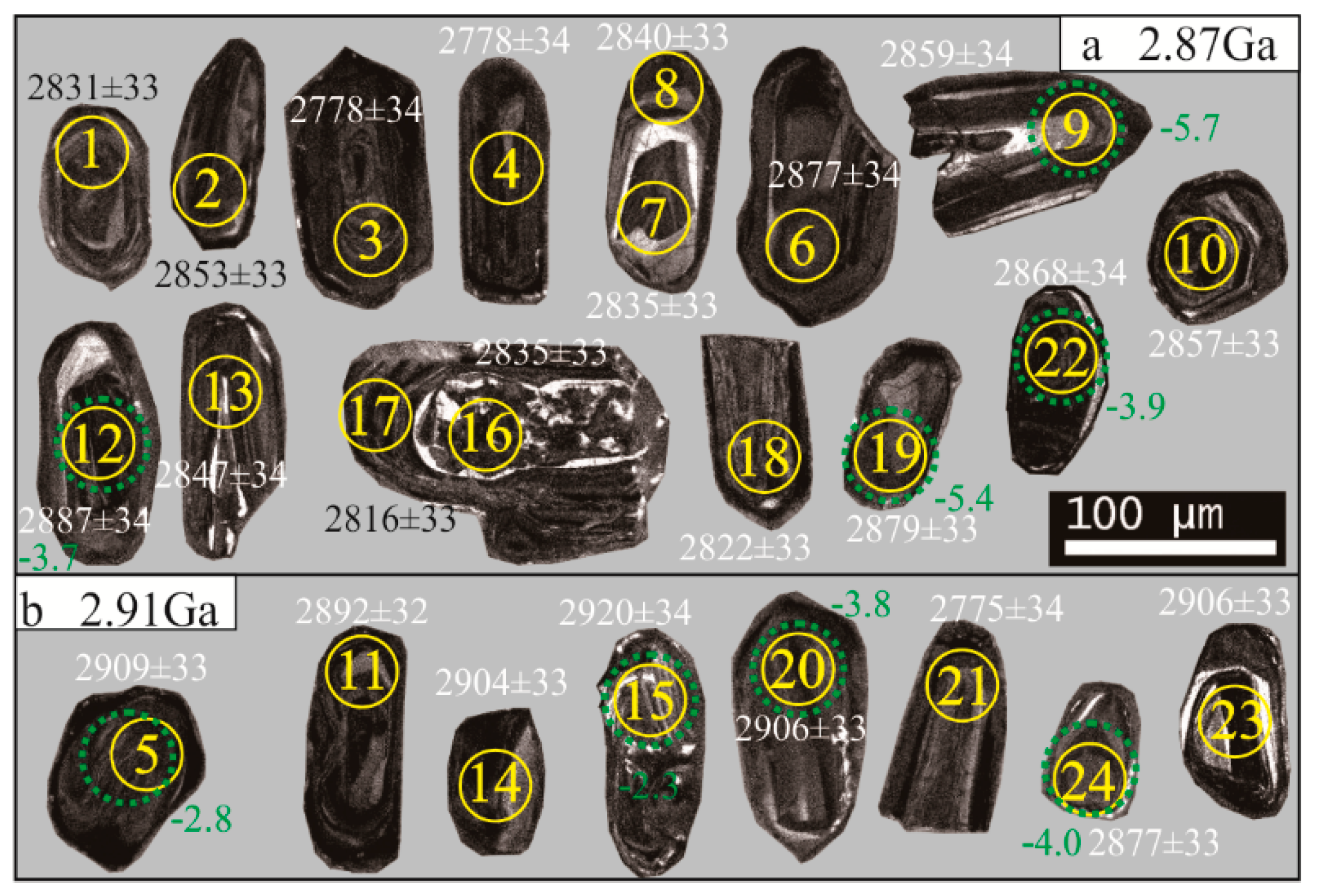
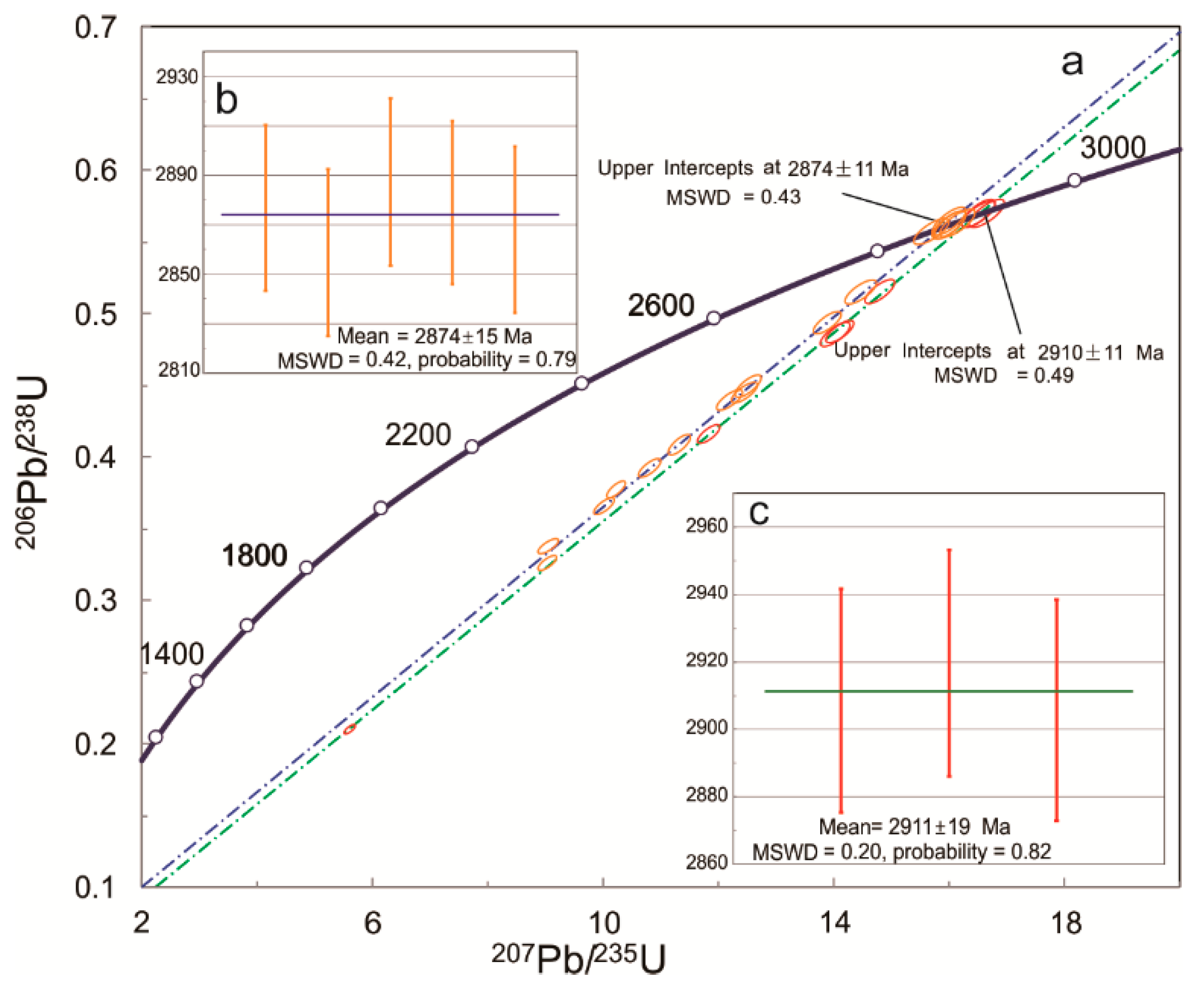
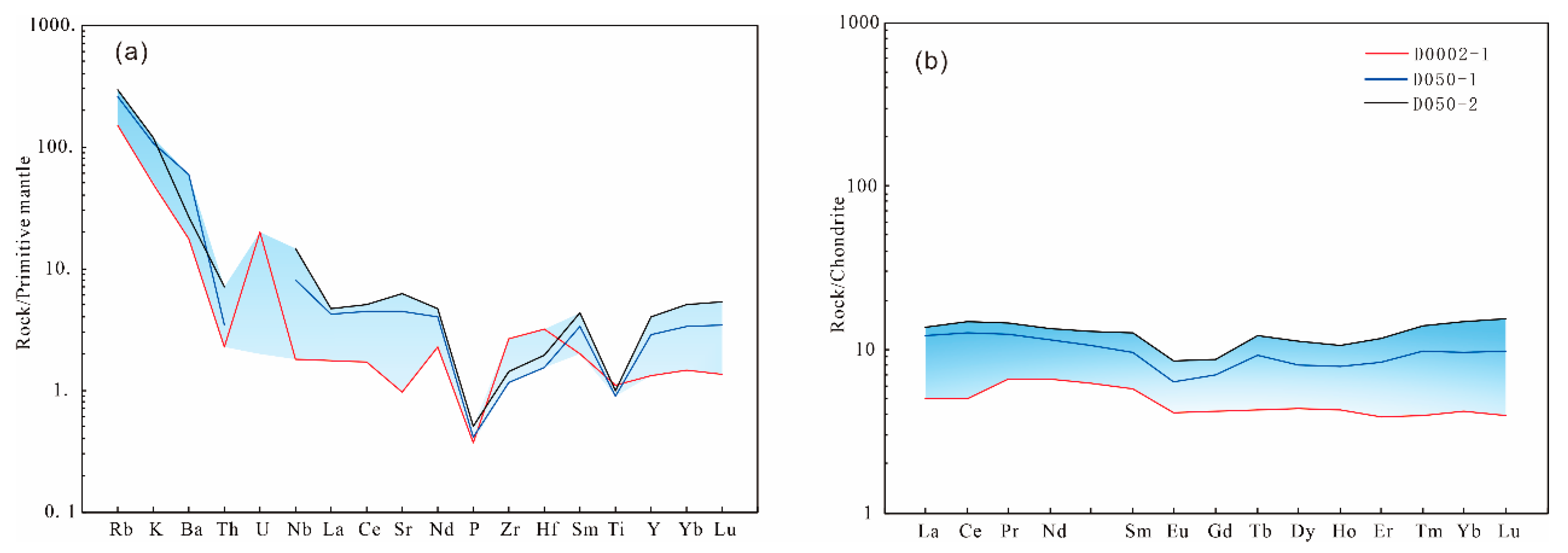
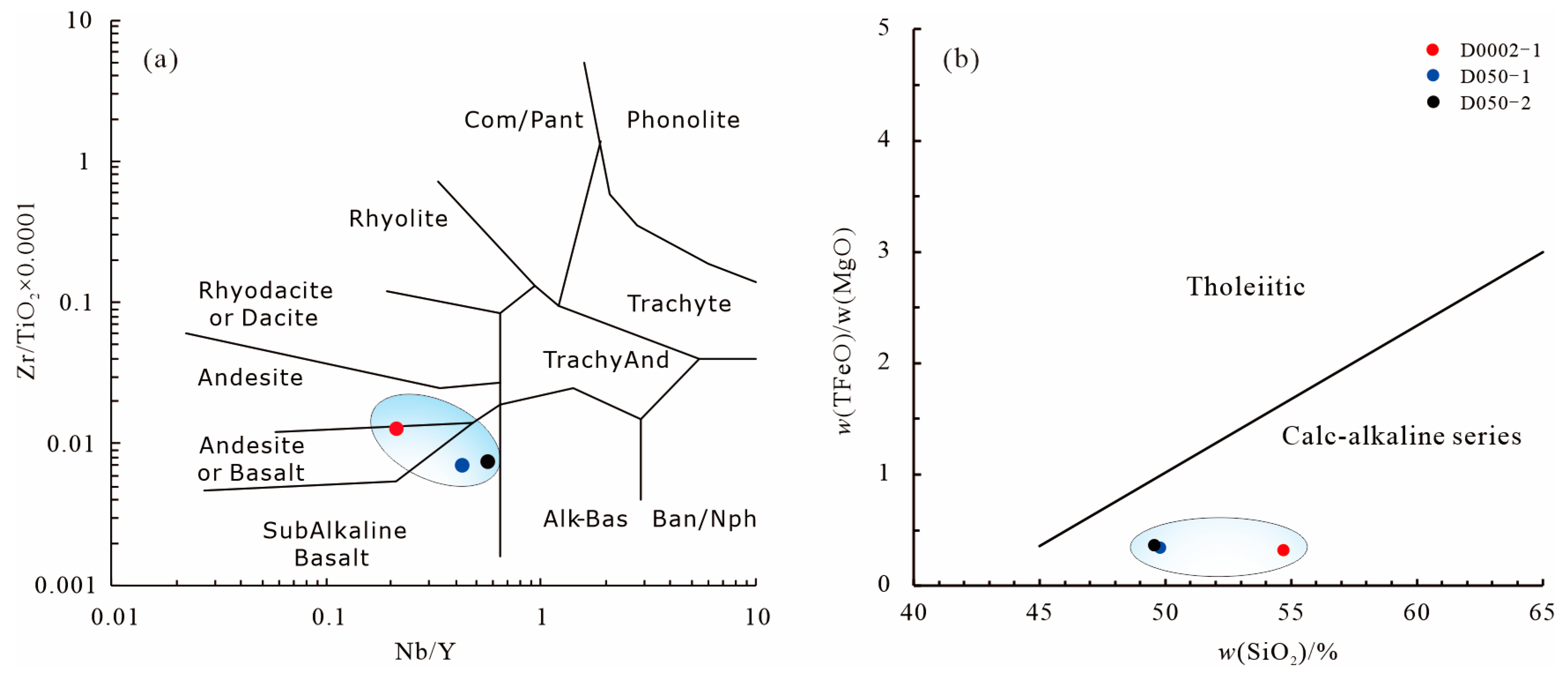
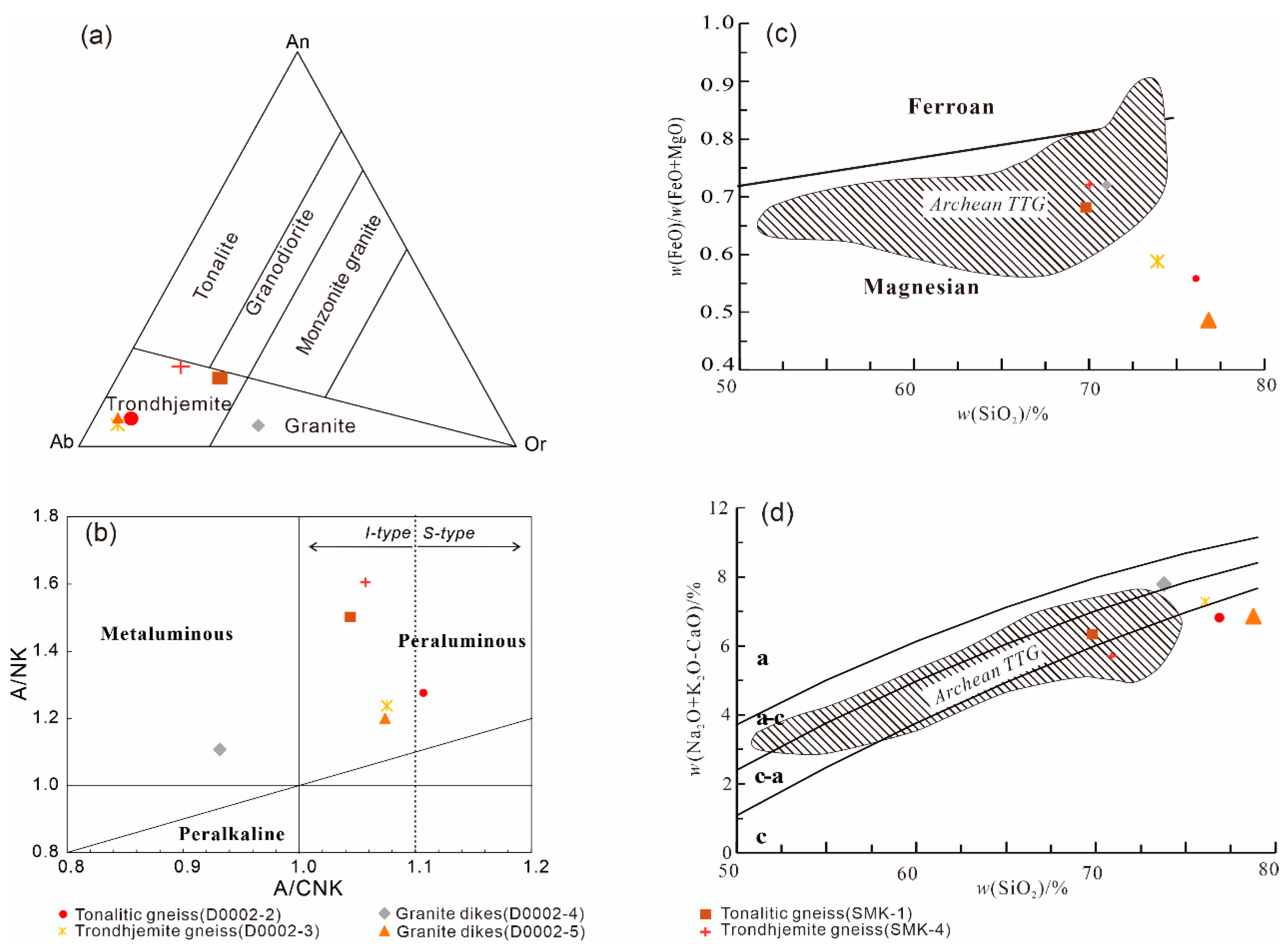
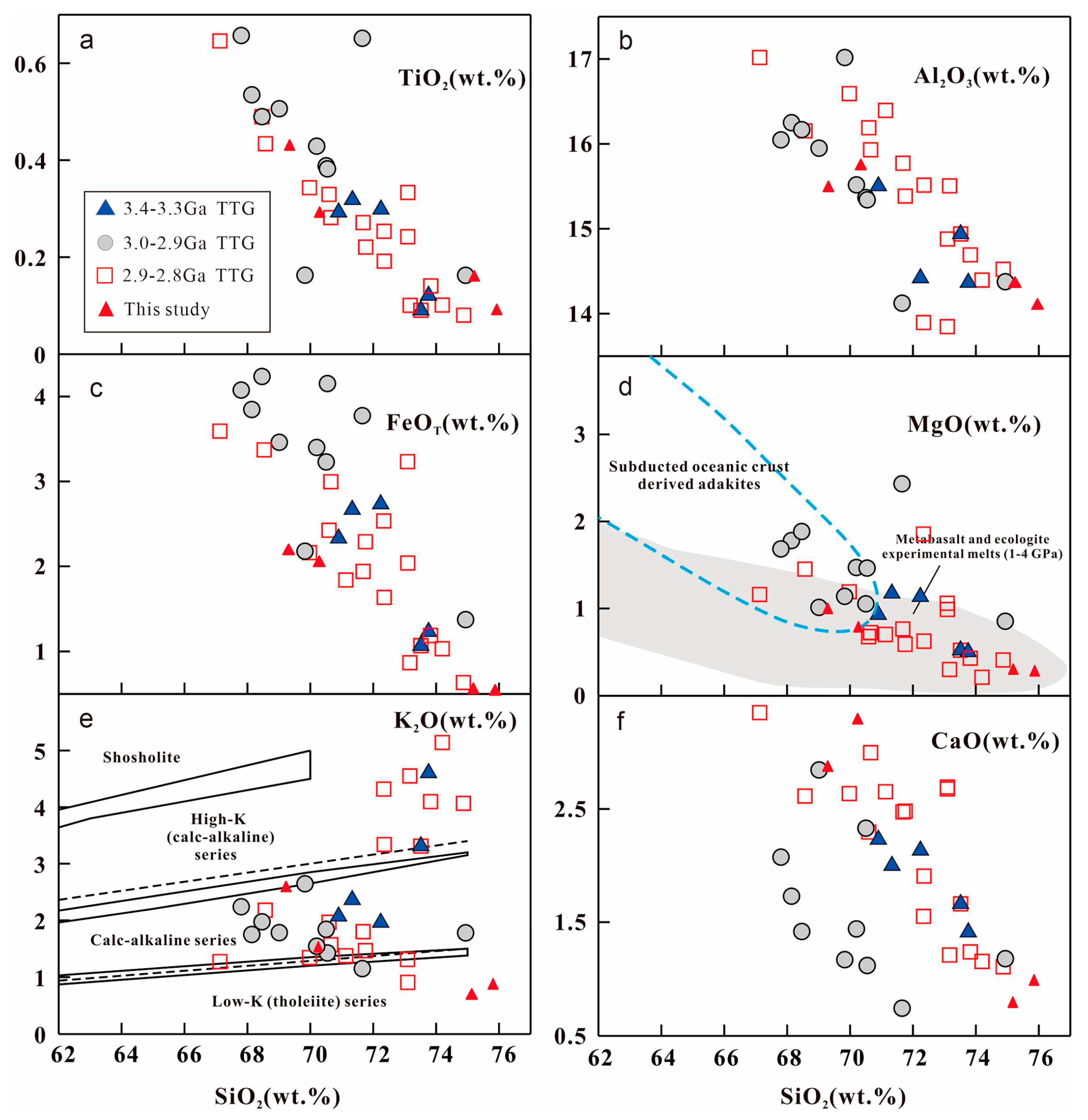

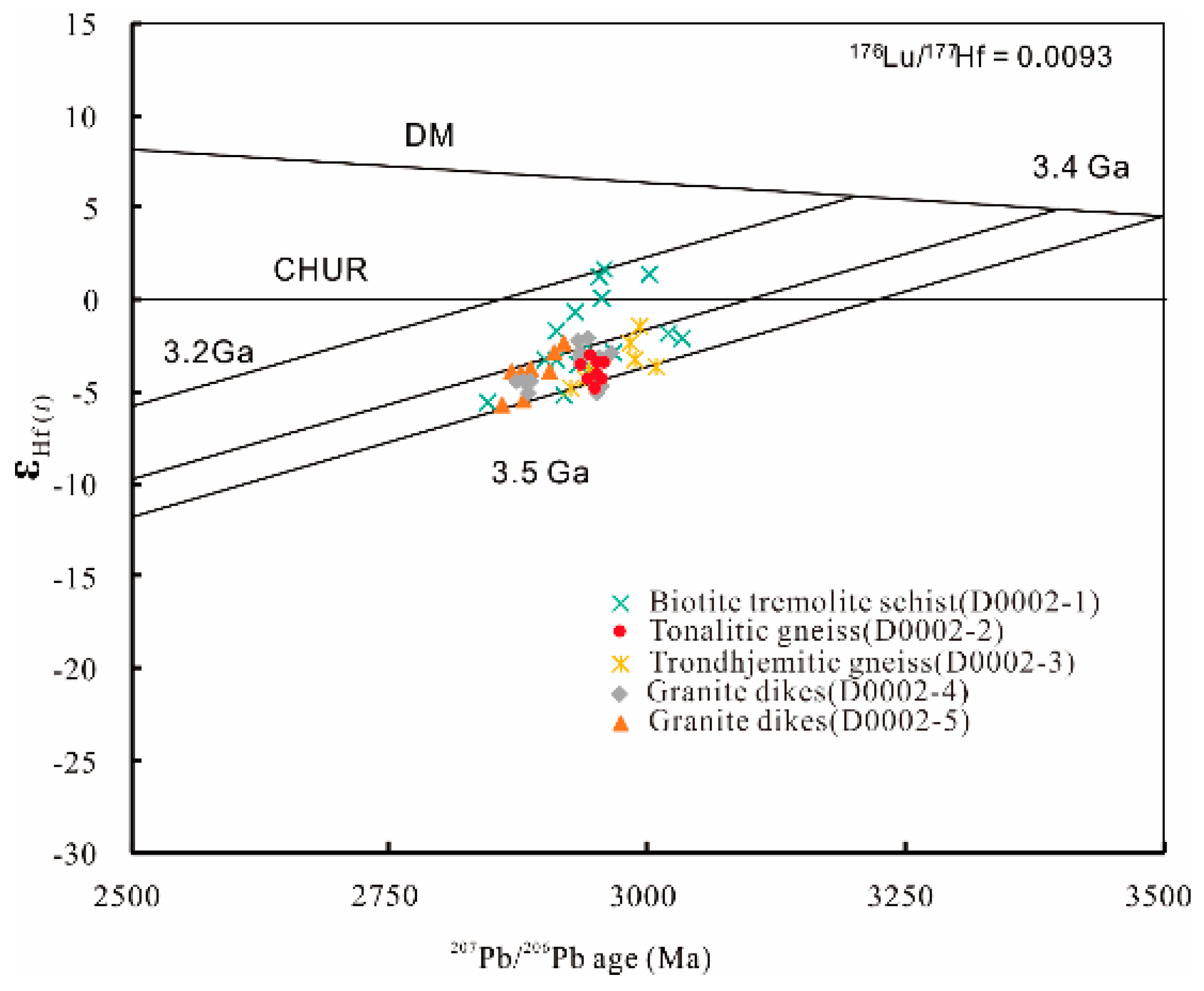
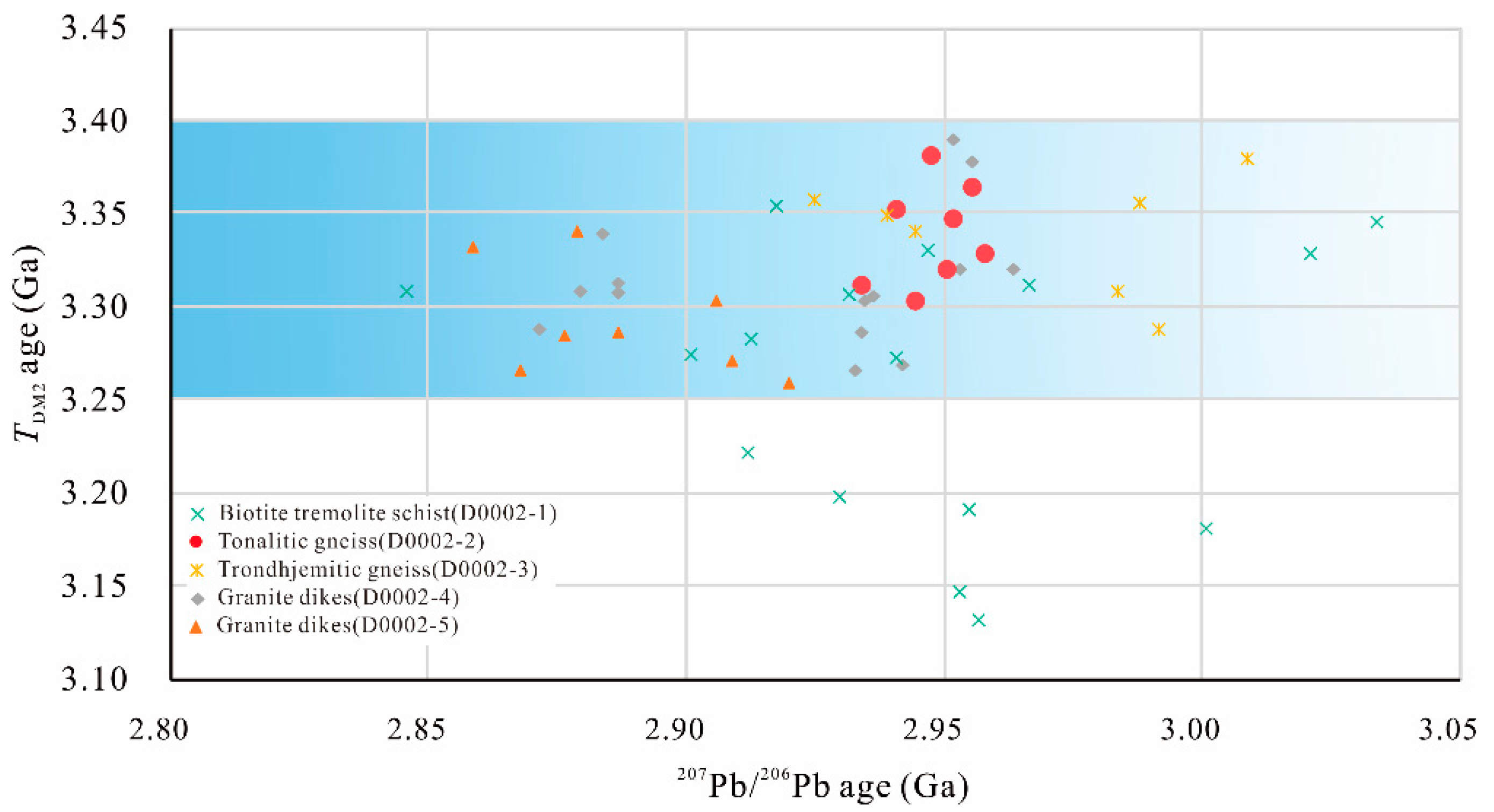
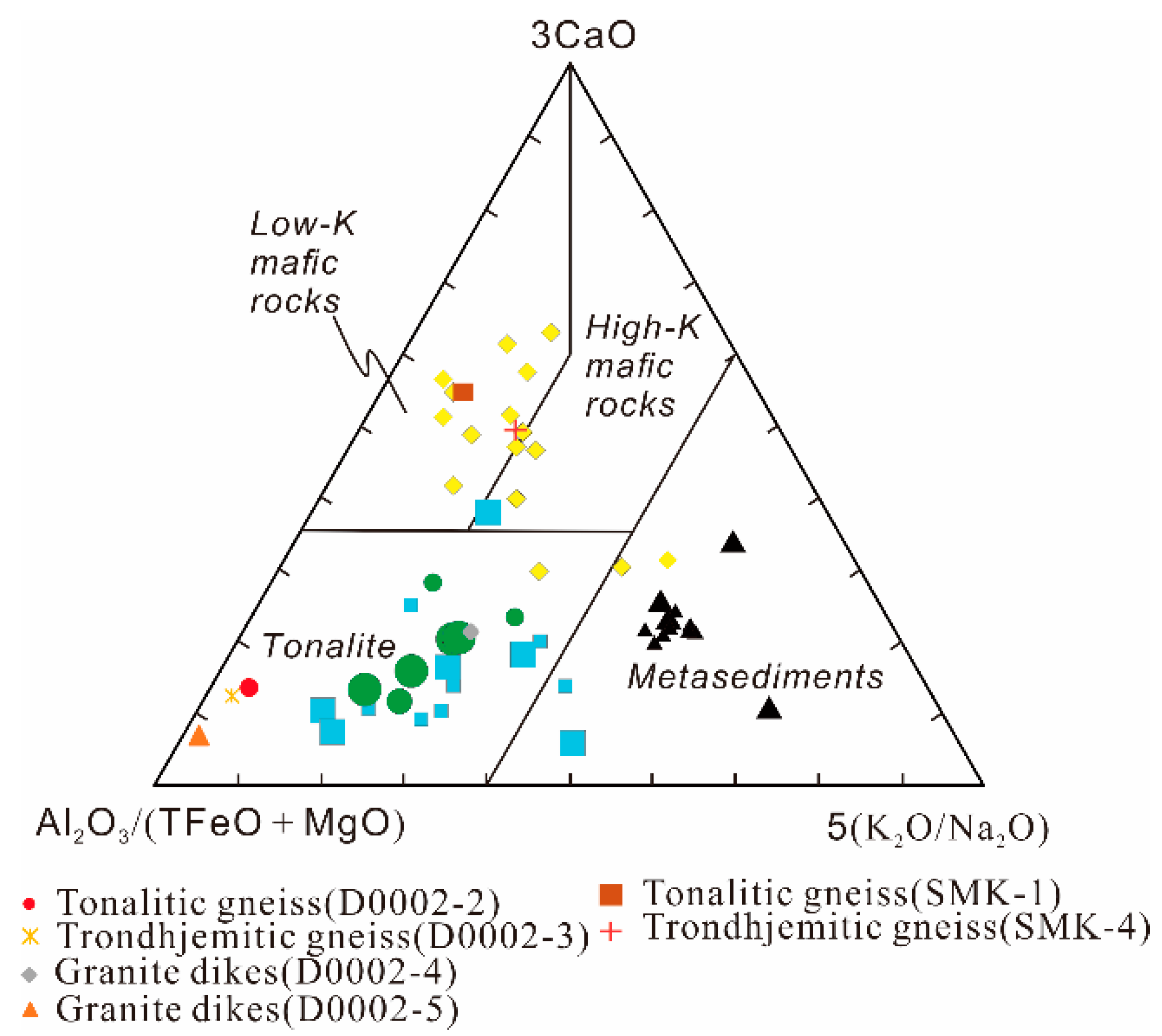
© 2019 by the authors. Licensee MDPI, Basel, Switzerland. This article is an open access article distributed under the terms and conditions of the Creative Commons Attribution (CC BY) license (http://creativecommons.org/licenses/by/4.0/).
Share and Cite
Wei, Y.; Zhou, W.; Hu, Z.; Li, H.; Huang, X.; Zhao, X.; Xu, D. Geochronology and Geochemistry of Archean TTG and Tremolite Schist Xenoliths in Yemadong Complex: Evidence for ≥3.0 Ga Archean Continental Crust in Kongling High-Grade Metamorphic Terrane, Yangtze Craton, China. Minerals 2019, 9, 689. https://doi.org/10.3390/min9110689
Wei Y, Zhou W, Hu Z, Li H, Huang X, Zhao X, Xu D. Geochronology and Geochemistry of Archean TTG and Tremolite Schist Xenoliths in Yemadong Complex: Evidence for ≥3.0 Ga Archean Continental Crust in Kongling High-Grade Metamorphic Terrane, Yangtze Craton, China. Minerals. 2019; 9(11):689. https://doi.org/10.3390/min9110689
Chicago/Turabian StyleWei, Yunxu, Wenxiao Zhou, Zhengxiang Hu, Haiquan Li, Xianxiao Huang, Xiaoming Zhao, and Daliang Xu. 2019. "Geochronology and Geochemistry of Archean TTG and Tremolite Schist Xenoliths in Yemadong Complex: Evidence for ≥3.0 Ga Archean Continental Crust in Kongling High-Grade Metamorphic Terrane, Yangtze Craton, China" Minerals 9, no. 11: 689. https://doi.org/10.3390/min9110689
APA StyleWei, Y., Zhou, W., Hu, Z., Li, H., Huang, X., Zhao, X., & Xu, D. (2019). Geochronology and Geochemistry of Archean TTG and Tremolite Schist Xenoliths in Yemadong Complex: Evidence for ≥3.0 Ga Archean Continental Crust in Kongling High-Grade Metamorphic Terrane, Yangtze Craton, China. Minerals, 9(11), 689. https://doi.org/10.3390/min9110689






